In conversation with commercial art visionary Zoë Allen
Naming your company Artistic Statements is, well, rather a big statement to make. But when setting up her inaugural art installation consultancy in 2019, Zoë Allen already had over 7 years experience of initiating and delivering art commissions in commercial settings.
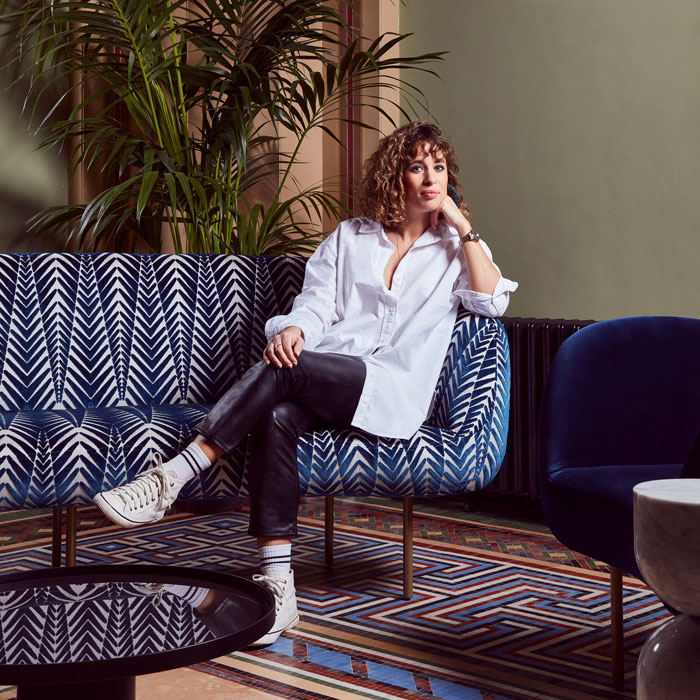
Photograph by Mark Cocksedge
Although it didn’t all begin there.
Before immersing herself in the world of art, Zoë’s academic studies included social anthropology and journalism, which was driven by a deep fascination for understanding people and the human condition. Post-academia, her intrinsic adventurous side took her on travel trips abroad to the likes of New Zealand and Australia where she used her empathy and skill for understanding others in various telesales jobs that ultimately paid for her excursions. This entrepreneurial instinct and innate ability to connect with others put her in good stead then, and on her return, helped her realise a passion for creativity in joining a small Shoreditch-based start-up that created unique artworks for offices. Joining the studio marked her entry into both the property and art industries, and whilst ultimately sales-based, offered creative freedom in spaces that would ordinarily not benefit from such aesthetics and energy. Her drive and enthusiasm for the role saw her earn a position as director of the company and gave her the time to hone her skill in building strong relationships with artists, landlords and developers alike. These experiences also deepened her understanding of storytelling in the built environment and the power of connection it creates with the user.
Going solo was a natural progression and has proven to allow even greater autonomy to collaborate with emerging artists and unleash creativity in public spaces. Drawing on her impressive network of creatives and customers alike she has already established an impressive portfolio of projects that capture the imagination and leave a lasting impression. It was my pleasure to chat with her and find out more about how she pulls off these stunning installations.
AB: It’s fascinating how your ability to build relationships and relate to people is at the core of your work, drawing from your background in social anthropology, not least because you work across 2 quite different industries.
ZA: Absolutely, people truly are at the heart of everything I do, and understanding both the corporate and creative industries allows me to navigate and bridge the gap between them. The property industry is very process driven, very corporate, and the creative industry isn’t. I wouldn’t like to be in just one of those sectors – it’s the interplay between them which aligns perfectly with my personality and approach.

78 St James Street, within a Grade II* listed building the artwork needed to complement the historic finishes and murals, whilst bringing the space into the modern era. Featuring Ben Rousseau Caillou Chaise
When it comes to delivering projects, it all starts with deeply understanding the needs and visions of my clients and the spaces they want to transform. It’s crucial to grasp the essence of what they seek to achieve, so I invest time in listening and empathising with their goals.
Working with artists is an integral part of the process, and I find that maintaining open and constructive communication with them is vital. I act as a conduit between the clients and the artists, providing valuable feedback in a way that encourages creativity and ensures that the client’s needs are met effectively. It takes a lot of empathy and understanding really.
AB: Could you walk me through your journey from client brief to end user experience.
ZA: As someone who thrives on doing things differently, I gravitate toward clients who share a progressive and forward-thinking mindset. The magic, in my opinion, lies beyond the comfort zone, and I’m always eager to push boundaries on both sides of the project.
When working with clients in the property industry, I encourage early involvement in the project, ideally a year or more before its completion. This allows us to view the building holistically and identify unique opportunities for showcasing artwork. Instead of sticking to the obvious spaces, like the big wall behind the reception desk, which is a bit old-school-thinking, I might suggest a space next to the window at street level where everyone walking past can see it. I think it’s important to move away from linear thinking when it comes to our interior design, architecture, wayfinding, furniture, and artwork. I want to explore the interplay between them and blur those lines – can we design a sculptural reception desk?! You know, can we look at this being a playful sculptural piece of furniture and take out that model of “do not touch” artwork signs that you have in galleries? I always refer to Heatherwick’s Rocking Chairs, they’re so playful and fun, but beautiful – works of art too. I’m always interested in pushing the boundaries of what art can be and in what sort of space it can reside.
To make this vision a reality, I seek visionary creatives and artists who can think outside the box. When presented with initial concepts, I encourage them to push the boundaries further. While this approach presents challenges during the technical design and fabrication process, it consistently delivers exciting and magical end results. I can bring in great fabricators, structural engineers and project managers to help bring it all the elements together, and it’s the strength of the team that allows the delivery of each new exciting project.
AB: I imagine there must be quite a collaborative underpinning to the work you do, maybe it’s helpful to use an example to illustrate this side of the process?
ZA: A perfect illustration of this approach is the Paul Cocksedge piece at The Rowe. The project was initiated through an open-ended client brief focused on creating a gallery-like experience within their office space. I asked the client what they wanted the space to feel like and they said they wanted visitor’s imaginations to be set on fire when entering.

Paul Cocksedge “Loop” designed for The Rowe London, this permanent installation celebrates both the metalworking past of the building itself and the rich textile history of the Whitechapel neighbourhood. Photograph by Mark Cocksedge.
This set the benchmark high, and I knew I needed a visionary creative that has really big ideas and thinks outside the box which lead me to collaborate with Paul. I remember when he first showed me that idea, you know, it genuinely gave me butterflies! It had such a rich story in its heart and was beautiful in terms of its finishes and the lighting and worked wonderfully within the rest of the architecture of the space.

Paul Cocksedge “Loop” designed for The Rowe London. Photograph by Mark Cocksedge
It was exciting to present it to the client but from there, the project involved intense technical design, detailing, engineering, and coordination. It was a case of buckling up for the rollercoaster ride. Delivering an installation at such a grand scale is complex, but the effort is undeniably rewarding. At the end of the journey, the installation becomes a legacy for the artist, the client, and myself. Witnessing the transformative impact on the space and the joy it brings to end-users is a source of immense satisfaction and drives my dedication to pushing boundaries in the art and property industries.
AB: Given the creative breadth and ambition of the projects you work on, I wonder how you source and begin to build relationships with artists and creatives?
ZA: Well, I try to stay up-to-date with worldwide happenings through platforms like Instagram and LinkedIn as well as being out and about in London. I love discovering something unique and exciting about an artist and enjoy pushing the boundaries of their medium. We might have an illustrator or graphic designer or somebody that predominantly works in 2D and explore how they can transform their work into stunning 3D installations. Then it’s about finding the right fabricators and buddying them up. But it’s about finding something special in an artist, and I have certain criteria in mind, like the richness of their story, beauty, inspiration, and their ability to harmonize with the space they’ll be placed in.
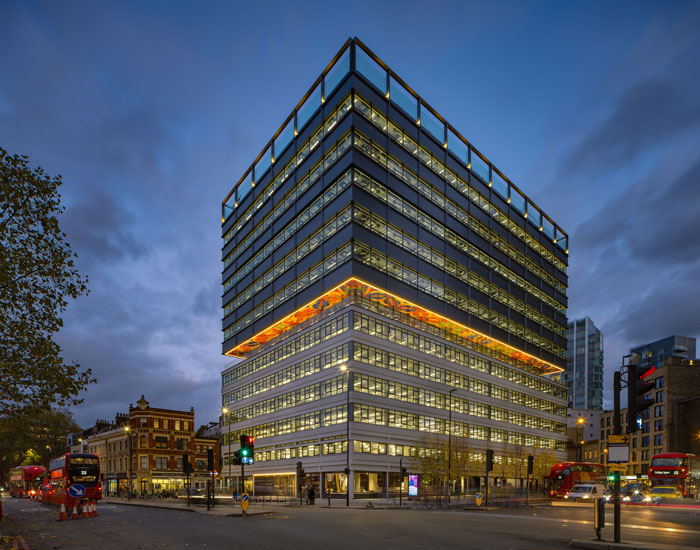
The Rowe, a 160,000 sqft office redevelopment in Whitechapel. Frasers Property UK
For me, it’s also about the energy a creative brings to the table. When I met Yinka Ilori, for example, I was blown away by his passion, warmth, and drive. I knew I wanted to work with him because he had that magical spark. Similarly, I occasionally meet artists who have that unique quality, and when the right project comes up, I just know they’d be perfect for it.
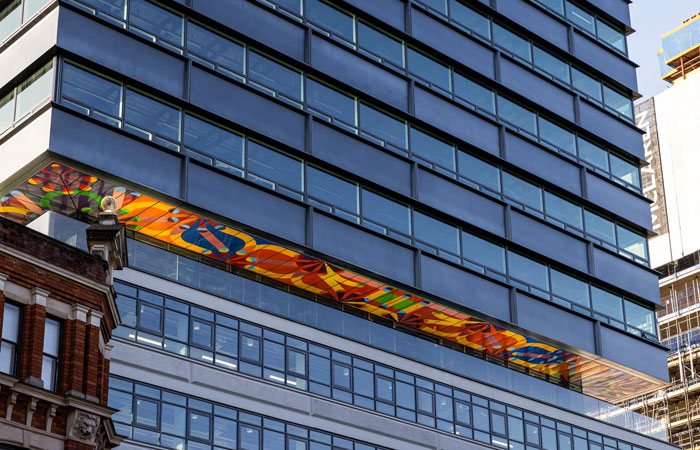
The Rowe, in Whitechapel. Wrap-around artwork on the terrace of the sixth floor, the top floor of the former building, by Yinka Ilori MBE. Frasers Property UK
There are various ways I find these artists. I find the emerging artists’ market particularly exciting. It’s about discovering talents who may not have worked on large installations or with certain materials before, and pushing them to explore new concepts and designs. Sometimes, it’s through networking within the property sector, where I might come across people who have a connection to the art world. Word of mouth and real-life encounters also play a significant role in discovering talent. It could be as simple as walking down the street and stumbling upon a captivating piece, or even attending parties where I’ve met exceptional artists.
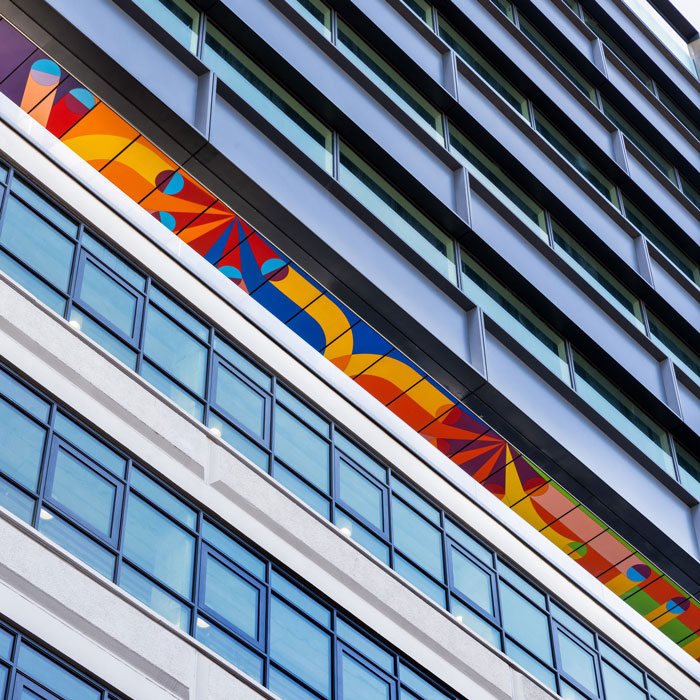
The Rowe in Whitechapel, artwork by Yinka Ilori MBE designed to reflect the long and varied textile traditions of the local community and can be seen from ground level. Frasers Property UK
In essence, I try to utilise every possible avenue, including social media like Instagram, to find these incredible artists. But I also place great importance on real-life interactions to truly understand their potential and find the right match for each project.
AB: We were really fortunate to feature your project, Rewilding Westfield, on Design Insider, which included a massive 1160 square meters of illustration. That’s truly impressive! Is scale an important factor for you when assessing a prospective project?
ZA: Absolutely, scale is crucial. In a world full of content and noise, art needs to stand out and make a significant impact. I never want art to be forgettable or unremarkable. Of course, art is subjective, and not everyone will be pleased, but working with scale allows us to create memorable and impactful installations.
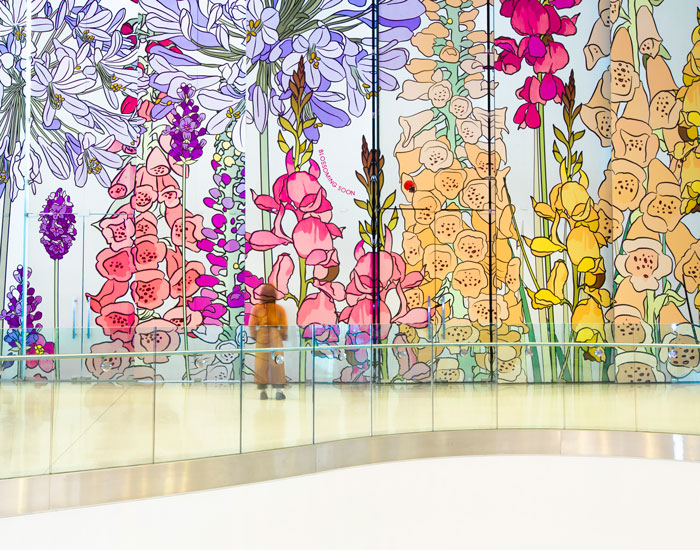
Graphic Rewilding. Photography by Katie Edwards
Take Westfield White City, for example, with its enormous space and 8-metre-high ceilings. Such a grand environment demands a big impact. Working with large-scale installations is thrilling because it reaches a broader audience and enhances accessibility to art for people who may not have easy access to the creative world. Using a shopping centre, especially in disused spaces, to bring art to unexpected places is a wonderful way to connect with diverse audiences and contribute to the community. It’s a win-win situation for all parties involved, and I truly love being a part of such projects.
AB: It is a truly beautiful project, and the use of AR technology was a fantastic way to immerse people in the artwork. Beyond that, how else do you bring soul into your work?
ZA: Nature has played a significant role in bringing soul into my installations. Sustainability is a hot topic, and I believe in celebrating and promoting it through art, drawing inspiration from nature itself. I’ve done several public art installations that involve actual planting and greenery, and the concept of rewilding is at the heart of many of my projects.
Bringing nature into urban environments, like shopping centres, adds a soulful element and transforms the perception of the space. I ask myself what value can I bring to the space that ordinarily wouldn’t be there – what’s going to drive people there and make them come back often? It’s that human thing. For instance, in Westfield White City, the urban setting was balanced with the integration of nature, creating a warm and inviting atmosphere. Biophilic design is incredible for achieving this effect. I always consider how I can add value to a space beyond its functional purpose. Often, it’s about infusing warmth and character, which can be achieved through materials, textures, scale, and storytelling. Nature, however, remains a powerful way to achieve that human connection with the environment.

Graphic Rewilding. Photography by Katie Edwards
In Rewilding Westfield, meeting artists like Lee Baker and Catherine Borowski was serendipitous. They are not only incredibly talented but also genuine, warm, and authentic individuals. I wanted to add another layer of value and in this day and age, we all experience the world through our phones. But working with them and integrating AR technology for the first time created a ground breaking experience. We wanted the viewers to feel fully immersed in the nature-inspired artworks, and it turned out to be a truly exciting collaboration. For me, it’s all about creating that sense of excitement and passion in everyone involved, from the artists to the project team to the clients. When we all share the same vision and push the boundaries together, we can produce works that are not only impactful but also genuinely memorable.
AB: Looking ahead, what’s next for you, and are there any specific artists or buildings you dream of working with?
ZA: I have been fortunate to work with some amazing clients who genuinely understand and value the importance of art and creativity in their spaces. So I’m always looking for landlords and developers that understand the value of art and culture. While I have primarily focused on projects in London and the UK, I am eager to explore opportunities abroad. Taking on international projects would be an exciting challenge and a lot of fun.
The name Artistic Statements reflects the broad scope of what I do, and I want to continue expanding my horizons. I’m open to collaborating with performance artists, exploring the world of fashion, incorporating music, and organising events and exhibitions. As for the artists I’d love to work with, there are far too many to mention. I keep a wish list on my Instagram, and it’s filled with incredible talents. Mixing and matching artists with diverse backgrounds, like lighting artists, illustrators, and creatives with architectural expertise, often leads to fascinating and unexpected results. Ultimately, I am drawn to those with a progressive mentality, both on the client and creative side. It’s about being open to stepping outside comfort zones, pushing boundaries, and creating meaningful and impactful experiences together.




